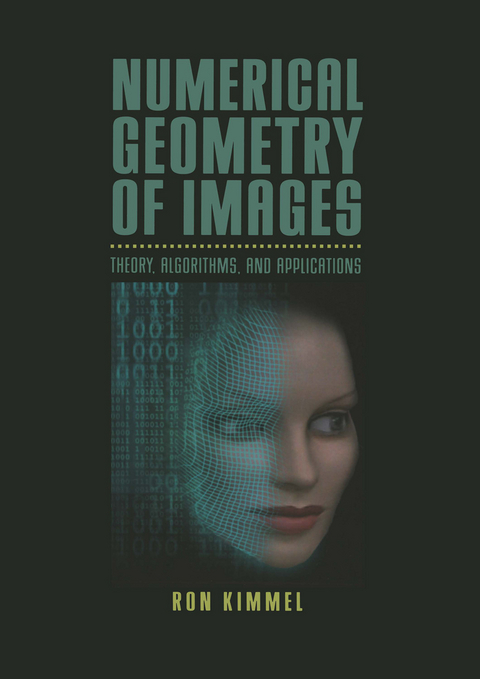
Numerical Geometry of Images
Springer-Verlag New York Inc.
978-1-4684-9535-5 (ISBN)
1 Introduction.- 1.1 Mathematical Tools and Machinery.- 1.2 Applications.- 1.3 Exercises.- 2 Basic Differential Geometry.- 2.1 Introduction to Differential Geometry in the Plane.- 2.2 Invariant Signatures.- 2.3 Calculus of Variations in Parametric Form.- 2.4 Geometry of Surfaces.- 2.5 A Brief Introduction to Intrinsic Geometry.- 2.6 Exercises.- 3 Curve and Surface Evolution.- 3.1 Evolution.- 3.2 Properties of Curve Evolution.- 3.3 Surface Evolution.- 3.4 Exercises.- 4 The Osher—Sethian Level Set Method.- 4.1 The Eulerian Formulation.- 4.2 From Curve to Image Evolution.- 4.3 Exercises.- 5 The Level Set Method: Numerical Considerations.- 5.1 Finite Difference Approximation.- 5.2 Conservation Laws and Hamilton-Jacobi Equations.- 5.3 Entropy Condition and Vanishing Viscosity.- 5.4 Numerical Methodologies.- 5.5 The CFL Condition.- 5.6 One-Dimensional Example of a Differential Conservation Law.- 5.7 Two-Dimensional Example of the CFL Condition.- 5.8 Viscosity Solutions.- 5.9 Summary.- 5.10 Exercises.- 6 Mathematical Morphology and Distance Maps.- 6.1 Continuous Morphology by Curve Evolution.- 6.2 Continuous-Scale Morphology.- 6.3 Distance Maps.- 6.4 Skeletons.- 6.5 Exercises.- 7 Fast Marching Methods.- 7.1 The One-Dimensional Eikonal Equation.- 7.2 Fast Marching on Two-Dimensional Rectangular Grids.- 7.3 Fast Marching on Triangulated Manifolds.- 7.4 Applications of Fast Marching on Surfaces.- 7.5 Exercises.- 8 Shape from Shading.- 8.1 Problem Formulation.- 8.2 Horn Characteristic Strip Expansion Method.- 8.3 Bruckstein’s Equal-Height Contours Expansion Method.- 8.4 Tracking Level Sets by Level Sets.- 8.5 Extracting the Surface Topography.- 8.6 Oblique Light Source.- 8.7 Summary.- 8.8 Exercises.- 9 2D and 3D Image Segmentation.- 9.1 The Level Set Geometric Model.- 9.2Geodesic Active Contours.- 9.3 Relation to Image Enhancement Methods.- 9.4 Nongeometric Measures and the Maupertuis Principle of Least Action.- 9.5 Edge Integration.- 9.6 Geometric Segmentation in 3D.- 9.7 Efficient Numerical Schemes.- 9.8 Exercises.- 10 Geometric Framework in Image Processing.- 10.1 Images as Surfaces.- 10.2 The Geometric Framework.- 10.3 Movies and Volumetric Medical Images.- 10.4 The Image Area as a Measure for Color Processing.- 10.5 The Metric as a Structure Tensor.- 10.6 Inverse Diffusion Across the Edge.- 10.7 Summary.- 10.8 Exercises.- 11 Texture Mapping, Matching Isometric Surfaces, and 3D Face Recognition.- 11.1 Flat Embedding.- 11.2 Texture Mapping.- 11.3 Isometric Signatures for Surfaces.- 11.4 Face Recognition.- 11.5 Exercises.- 12 Solutions to Selected Problems.
| Erscheint lt. Verlag | 31.8.2012 |
|---|---|
| Illustrationen | M. Bronstein, A. Bronstein |
| Zusatzinfo | 254 Illustrations, black and white; XIII, 209 p. 254 illus. |
| Verlagsort | New York, NY |
| Sprache | englisch |
| Maße | 178 x 254 mm |
| Themenwelt | Informatik ► Grafik / Design ► Digitale Bildverarbeitung |
| Mathematik / Informatik ► Informatik ► Software Entwicklung | |
| Informatik ► Theorie / Studium ► Künstliche Intelligenz / Robotik | |
| ISBN-10 | 1-4684-9535-6 / 1468495356 |
| ISBN-13 | 978-1-4684-9535-5 / 9781468495355 |
| Zustand | Neuware |
| Haben Sie eine Frage zum Produkt? |
aus dem Bereich


